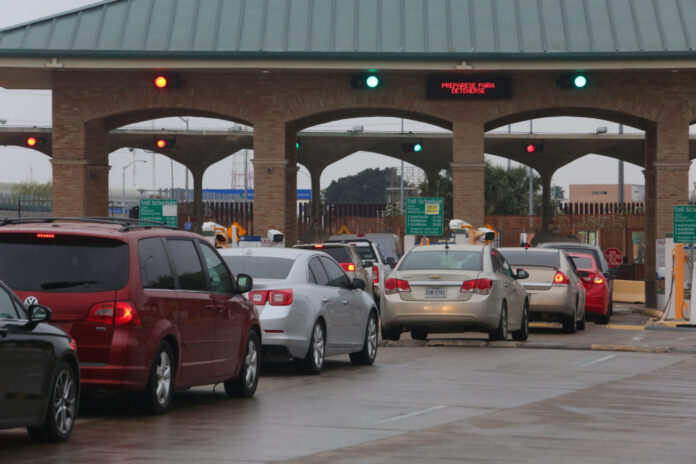U.S. Customs and Border Protection officials clarified early Friday afternoon that the U.S.-Mexico border is not closed, but travelers’ access will be limited.
Not long after President Trump announced the U.S.-Mexico southern border would be closed off to “non-essential” travelers Friday morning, CBP officials released a statement further clarifying how the border would be limited beginning Friday at midnight.
“Both our countries know the importance of working together to limit the spread of the virus and to ensure the commerce that supports both our economies keeps flowing,” Secretary of State Michael R. Pompeo said after announcing the agreement with Mexico.
Essential travel includes, but is not limited to the following, U.S. citizens or permanent residents returning to the U.S., people traveling for medical purposes, in the case of receiving treatment in the U.S., people traveling to attend educational institutions, and those returning to the U.S. in the agriculture and farming industries.
Additionally, anyone traveling as part of an emergency response team, government officials, or emergency responders, and those who work in cross-border trade, such as truck drivers moving cargo between the U.S. and Mexico.
This initiative is expected to begin Friday at midnight, and end at midnight April 20, 2020, according to a release from the U.S. Department of Homeland Security.
Non-essential travel is considered to be tourism, or recreational in nature, examples given include sightseeing, gambling, or attending a cultural event.
The new border restrictions, along with those with Canada that were announced Wednesday “will protect the health of all three nations and reduce the incentive for a mass global migration that would vastly deplete the resources that are all needed,” Trump said.
“We are treating both borders equally … northern and southern borders,” Trump said.
CBP officials state that they may “limit the number of open vehicle primary lanes to maintain operational control of all travelers seeking entry to the United States,” the release from CBP stated.
Travelers who do not meet the above description, would be returned to Mexico.
“Restricted travelers will be returned to their last point of origin (Mexico or Canada) and CBP will suspend case processing of inadmissible individuals, to include those subject to travel restrictions pursuant to Section 212(f) of the INA,” the release stated.
The restrictions on both the northern and southern land borders are needed because “we cannot be preventing people from coming in from one area when they can come in from another,” Dr. Anthony Fauci, said, explaining the need to close both major borders, not just one.
“There’s a public health reason for doing that.”
U.S. Rep. Vicente Gonzalez, D-McAllen, who has been in self-quarantine since Thursday, released a statement regarding the travel restrictions at the U.S.-Mexico border Friday afternoon.
“The U.S. and Mexican governments have deemed non-essential travel to and from Mexico necessary to protect the health and safety of the American and Mexican people. Commerce and essential travel will be allowed. Mexico is an invaluable trade partner and friend, and I look forward to the day we can lift these restrictions. My office is open to help those Americans who may be stuck in Mexico or have questions regarding these new travel restrictions,” Gonzalez said in the prepared statement.
Trump said he did not think there was a need for a national lockdown. “I don’t think we’ll ever find that necessary,” he said, noting that while some states have large numbers of cases, others are “watching it on television.”
The State Department on Thursday issued its highest level of travel advisory, urging all U.S. citizens not to travel abroad. The Level 4: Do Not Travel advisory “advises U.S. citizens to avoid all international travel due to the global impact of COVID-19.”
Mexican Foreign Minister Marcelo Ebrard downplayed the border news while speaking to journalists Friday morning, repeatedly saying that the changes do not amount to a closure.
“We are not talking about a closure because it is not that,” he said at a news conference in Mexico City. “It is going to be restricted, specifically for tourism and recreation.”
Even a partial closure of the border, however, was likely to affect Mexico’s struggling economy. Mexico posted near flat growth last year and now appears headed for recession, analysts say. This week, the peso tumbled to a historical low amid growing concerns about the impact of the virus and a related dip in oil prices.
Every day, more than $1.6 billion in goods and services flow across the border, according to the U.S. Chamber of Commerce. So, too, do roughly half a million legal workers, students, shoppers and tourists, who cross with visas.
Keeping the border open has been a major priority of Mexican President Andres Manuel Lopez Obrador. In the face of threats by Trump to close the border entirely in the past unless Mexico does more to stop illegal immigration, Lopez Obrador responded by quickly ramping up deportations of Central American migrants.
Jodi Goodwin, an immigration lawyer in the Texas border city of Brownsville, called the border closure “tragic” for potential immigrants who have been stranded, in some cases for many months, in efforts to enter the U.S.
“I and the few other warrior lawyers here on the border depend on going to Mexico to be able to represent our clients. Not being able to travel to Mexico makes things monumentally more difficult,” Goodwin said.
She said technology like FaceTime and messaging services, “absolutely is not able to replace in person meetings, especially dealing with people who are victims of trauma and trafficking.”
Already on Friday morning, asylum-seekers she represents in the Remain in Mexico program had hearings at a border tent court postponed — they were not told why, she said. About 2,000 asylum-seekers have been living in a tent camp on the other side of the Brownsville border bridge in Matamoros, some for months.
___
This report includes reporting by the Los Angeles Times.




